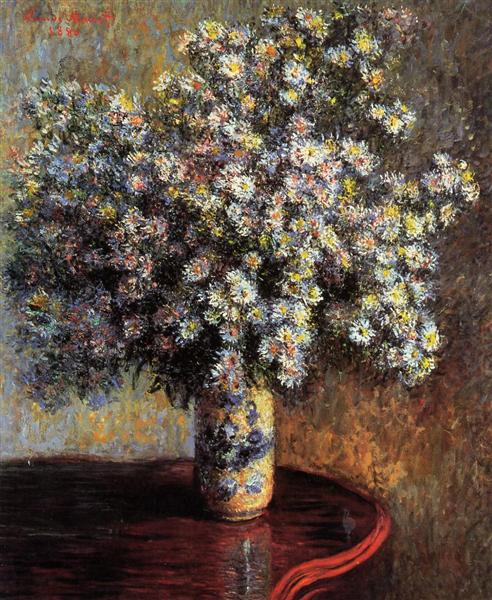Beskrivelse
Claude Monets "ásteres" -arbejde, malet i 1880, er en fremragende repræsentation af kunstnerens talent og følsomhed over for naturen og de mest subtile elementer i hans omgivelser. Monet, en af grundlæggerne af den impressionistiske bevægelse, stod ud for hans evne til at fange lys og farve i hans værker, og i "Ranters" skuffer ikke. Maleriet viser os et arrangement af Aster Flowers, et emne, der henviser til både den forbindelse, som kunstneren havde med sin have og den livlige palet, der kendetegner hans arbejde på dette tidspunkt.
Når man observerer sammensætningen, er det tydeligt, at Monet bruger en næsten abstrakt tilgang. Blomsterne er arrangeret i en vase, og selvom der er en klar anerkendelse af ástererne som emne, føles deres fortolkning friere og mere poetisk end bogstavelig. Kunstneren bruger løse og dynamiske børstestræk, der giver en følelse af bevægelse, næsten som om blomsterne blev agiteret forsigtigt med en leg. Gennem denne teknik formår Monet at overføre blomsterens flygtige skønhed, et koncept, der dybt resonerede med sin interesse for at fange flygtige øjeblikke. Dette arbejde er et fremragende eksempel på dets modne stil, der er kendetegnet ved en tilgang til atmosfæren og lyset, der stripper maleriet af stive detaljer og traditionelle chiaroscuro.
Brugen af farve i "ásteres" er fascinerende. Monet vælger en rig palet, der strømmer fra de dybe og blå violer af Ásteres til den pulserende grønne og de cremede toner, der antyder miljøets lysstyrke. Denne interaktion mellem farver fejrer ikke kun blomsterens skønhed, men skaber også en harmonisk effekt, der omgiver seeren. Farvezoner ser ud til at vibrere fra hinanden, hvilket er en karakteristisk segl af impressionisme og et udtryk for studiet af naturligt lys. Monet bruger med sin kapacitet til detaljeret observation variationen af toner og skygger for at opnå en visuelt forførende ro, der inviterer øjet til at udforske hvert hjørne af lærredet.
Hvad angår maleriets historie, er "Wean" et klart eksempel på Monets interesse i naturen og hans daglige liv i Giverny, hvor han intenst dyrkede sin have. Dette sted blev et levende laboratorium for maleren, et scenarie, hvor det kunne fange ændringerne af lys og farve i sine blomster langs stationerne. Selv om det ikke skiller sig ud for tilstedeværelsen af menneskelige figurer, føles det intimt og fuldt af liv, da blomsterne selv ser ud til at være hovedpersonerne, der fremkalder en følelse af aktivitet, tilstedeværelse og på samme tid af skrøbelighed.
Sammenfattende repræsenterer "We" ikke kun en episode i Monets karriere, men er også et vidnesbyrd om hendes mestring i manipulation af farve, lys og form. Gennem en impressionistisk tilgang, der omfavner den organiske og den følsomme, omdanner Monet en simpel vase af blomster til en visuel meditation om den flygtige skønhed, der omgiver os. Denne tilgang, der er karakteristisk for hans arbejde, inviterer tilskuere til at overveje verden gennem en anden linse, hvor hverdagen bliver ekstraordinær, og virkeligheden fortolkes i et spil lys og farve. Monets intime forbindelse med det omgivende miljø bliver håndgribelig her, en påmindelse om livet, der blomstrer med ekstravagance og delikatesse.
KUADROS ©, en berømt maling på din væg.
Håndlavede olie -malerier med kvaliteten af professionelle kunstnere og den karakteristiske segl af KUADROS ©.
Billeder reproduktionstjeneste med tilfredshedsgaranti. Hvis du ikke er helt tilfreds med kopien af dit maleri, refunderer vi dine penge 100%.

